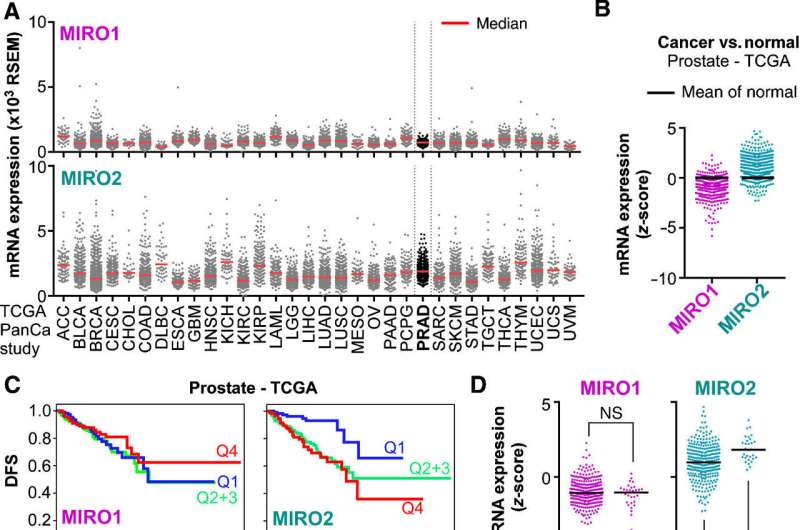New study shows how tumor cells use mitochondria to keep growing

Hormone therapy is often used to treat prostate cancer that has spread to other parts of the body, but many patients develop resistance to hormone therapy, causing their disease to become more aggressive and potentially more deadly.
"One of the big challenges we have in the field is that the majority of prostate cancer therapies target hormones—the androgen axis," says University of Colorado Cancer Center mentored member Cecilia Caino, Ph.D. "But nearly all patients develop resistance to those drugs and then get a more aggressive disease that starts moving to other parts of the body. It's been confined to the prostate, but now it might move over to the bones or the liver, or the lungs. That's really a big problem, because when you start to compromise the vital organs, the patient eventually will die."
In spring 2021, Caino received an Idea Award from the U.S. Department of Defense's Peer Reviewed Cancer Research Program to investigate the role of mitochondria—the small energy factories in cells that help to break down food into fuel—in metastatic prostate cancer.
In initial research recently published in the journal Molecular Cancer Research, Caino and her co-investigators discovered that tumor cells use mitochondria to control their growth and detect stress that can destroy a tumor cell if it is not controlled. In addition to the Department of Defense, the research is funded by the American Cancer Society, the Boettcher Foundation, and the National Institute of General Medical Sciences.
"We know that tumor cells are very resistant to stress in general; that's what makes them so hard to target with therapies," Caino says. "But when the tumors grow too fast, they start running out of nutrients to keep building. They utilize this mitochondrial pathway that we describe to slow down for a moment, adapt, and expand their capacity to synthesize more blocks to build the cells."
A compound to target
Caino and her team also found that a mitochondrial protein called MIRO2 is overexpressed in metastatic prostate cancer tumors. Having previously found that MIRO2 works together with two other proteins called GCN1 and GCN2 to help metastatic prostate cancer cells tolerate conditions where growth of normal cells would be prevented, Caino now hypothesizes that targeting this protein compound can inhibit the mitochondrial process that prevents tumor cells from destroying themselves by expanding too quickly.
"Our next step is to treat animal models that have metastases and see if we can eliminate the tumor or prevent the metastasis from even occurring in the first place," she says. "We're also learning a lot more about the complex, because we want to know how it's regulated. That will help us stratify patients who will benefit from the therapy from those who will not."
The researchers will start out treating the metastasis with an existing drug used to treat acute lymphocytic leukemia, but Caino also hopes to eventually design a drug that would prevent the complex from forming in the first place.
"A lot of times drugs work for a while, then they stop working. You already have to be thinking about what you're going to do when that drug doesn't work anymore," she says. "Hopefully we can come up with a strategy to stop the process farther upstream."
Milestone research
Caino is especially excited about this research as it represents her first peer-reviewed paper as a senior corresponding author. It also marks 22 years from her first experience in lab research.
"I decided to start a new line of research that did not stem directly from my postdoctoral studies," she says. "I also chose to begin my lab with a couple of graduate students and a technician, investing in their training while remaining involved in bench work myself. Walking this long, winding road was challenging and called upon every single skill and strength I had."
More information: Madison Furnish et al, MIRO2 Regulates Prostate Cancer Cell Growth via GCN1-Dependent Stress Signaling, Molecular Cancer Research (2022). DOI: 10.1158/1541-7786.MCR-21-0374


















